Consumer Behavior in eCommerce: Key Insights, Impact, and Strategies For Growth
Imagine walking into a local store where the shopkeeper knows your preferences, recommends products, and offers a personalized experience. Now, compare that to the modern eCommerce consumer behavior world, where brands must work harder to capture attention in a crowded digital space.
Today, 87% of shoppers research online before making a purchase, meaning they are more informed and selective than ever. Traditional marketing tactics no longer work as they once did—businesses must adapt to consumer expectations.
By understanding online consumer behavior in shopping, businesses can identify what customers truly want, improving their experience and loyalty. Tracking browsing habits and purchase patterns helps brands offer personalized recommendations, making shopping more engaging.
With consumer behavior constantly shifting, online businesses rely on advanced analytics to stay ahead. Keeping up with these trends isn’t just important—it’s necessary to remain competitive.
Read this blog to discover how customer behavior is evolving, the key factors driving these changes, and what they mean for your business.
What is Consumer Behavior in eCommerce Marketing?
Firstly, what is consumer behavior? It is the study of how consumers think, feel, act, and make decisions when purchasing products. From the moment they recognize a need to the time they buy and provide feedback, consumer behavior in eCommerce encompasses every step of their journey.
It involves analyzing how, what, when, and why people buy certain items. Businesses must understand how their audience interacts with their brand, market, or product and how they fulfill their needs— both emotionally and physically.
Consumer behavior is constantly evolving, especially in response to external factors. For example, in 2020 during COVID time, Nielsen revealed that 69% of people purchased household items online for the first time, illustrating how circumstances shape buying habits.
By studying online shopping behavior, businesses can answer critical questions: What do consumers do? Why do they choose certain products? When and how often do they shop? Understanding these customer behavior insights helps brands adapt and enhance customer experiences effectively.
– Also Read- Ecommerce Video Marketing: What Works And What’s Next
Key Factors That Influence Consumer Behavior
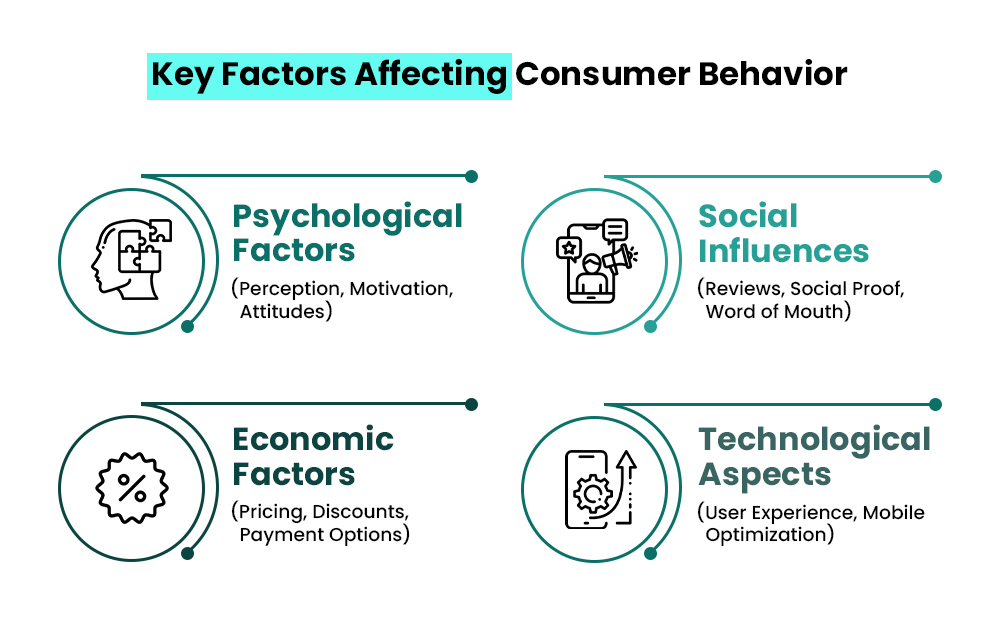
Multiple factors affect consumer behavior and each eCommerce brand needs to know and keep in consideration. Here are some of them:
1. Psychological Factors (Perception, Motivation, Attitude)
Psychological factors like perception, motivation, and attitude significantly shape purchase decisions. Consumers interpret products based on personal experiences, needs, and beliefs. Understanding these factors is crucial for creating targeted marketing strategies that drive engagement and conversions in eCommerce.
2. Social Influences (Reviews, Social Proof, Word of Mouth)
Social influences like reviews, social proof, and word of mouth play a crucial role in shaping buying decisions. Consumers trust peer recommendations over ads, making reputation management vital. Understanding this behavior is essential for building credibility and driving sales in eCommerce.
3. Economic Factors (Pricing, Discounts, Payment Options)
Pricing strategies, discounts, and varied payment options significantly impact online purchasing behavior. Consumers are highly sensitive to price and discounts can incentivize purchases. Flexible payment methods enhance convenience and influence buying decisions. Understanding these factors helps businesses optimize strategies to enhance customer satisfaction and boost eCommerce sales.
4. Technological Aspects (User Experience, Mobile Optimization)
Technological aspects like user experience and mobile optimization greatly impact eCommerce success making them a crucial factor in the consumer journey. Intuitive navigation and a responsive design enhance online purchasing behavior. Poor user experience directly impacts checkout processes and cart abandonment rates, affecting conversions.
How Do Businesses Track Online Shopping Patterns?
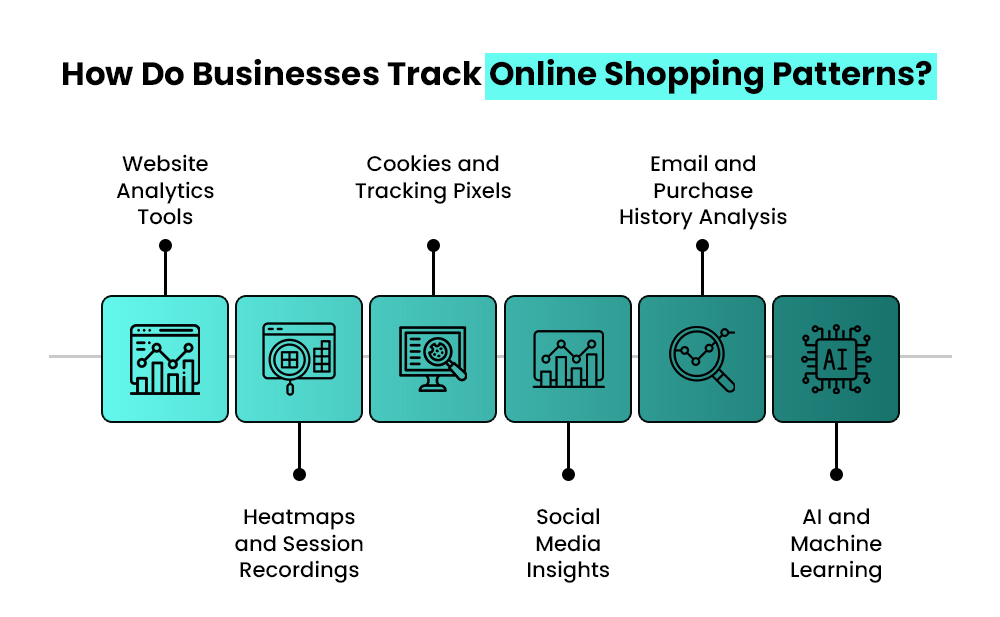
Understanding online shopping patterns is essential for businesses for their success. Businesses employ various tools and technologies to monitor and analyze how online shoppers interact with their platforms.
This data-driven approach optimizes marketing strategies, enhances user experiences, and increases conversion rates. Here’s how businesses can easily track online consumer shopping behavior patterns:
Website Analytics Tool
Platforms like Google Analytics monitor user activities, including page views, time spent on the site, and navigation paths. This information helps businesses identify which elements attract and retain customers, allowing for data-driven improvements.
Heatmaps and Session Recordings
Heatmap tools visualize user engagement by highlighting areas where online shoppers click, scroll, and hover. Session recordings offer detailed insights into browsing behaviors, enabling businesses to refine website layouts and enhance user experiences.
Cookies and Tracking Pixels
Cookies store user preferences and past behaviors while tracking pixels monitor interactions with advertisements. This data facilitates personalized recommendations and effective retargeting strategies, aligning offerings with individual consumer interests.
Social Media Insights
Analyzing engagement metrics, such as likes, comments, and shares allows businesses to measure consumer interests and emerging trends. Social listening tools further track brand and product discussions, providing a deeper understanding of consumer sentiment.
Email and Purchase History Analysis
Examining open email rates, click-through rates, and purchase histories enables customer segmentation and the delivery of targeted offers. This personalized approach develops customer loyalty and drives repeat business.
AI and Machine Learning
Advanced algorithms analyze extensive datasets to predict consumer shopping behavior. By identifying patterns and preferences, AI aids in personalizing shopping experiences and anticipating marketing trends.
By leveraging these tracking methods, businesses gain comprehensive insights into consumer preferences and behaviors. This understanding is essential for refining strategies, providing seamless shopping experiences, and meeting the evolving needs of online shoppers.
– Also Read- 10+ Content Marketing Trends to Watch Out for Businesses in 2025
The Impact of Consumer Behavior on eCommerce Businesses
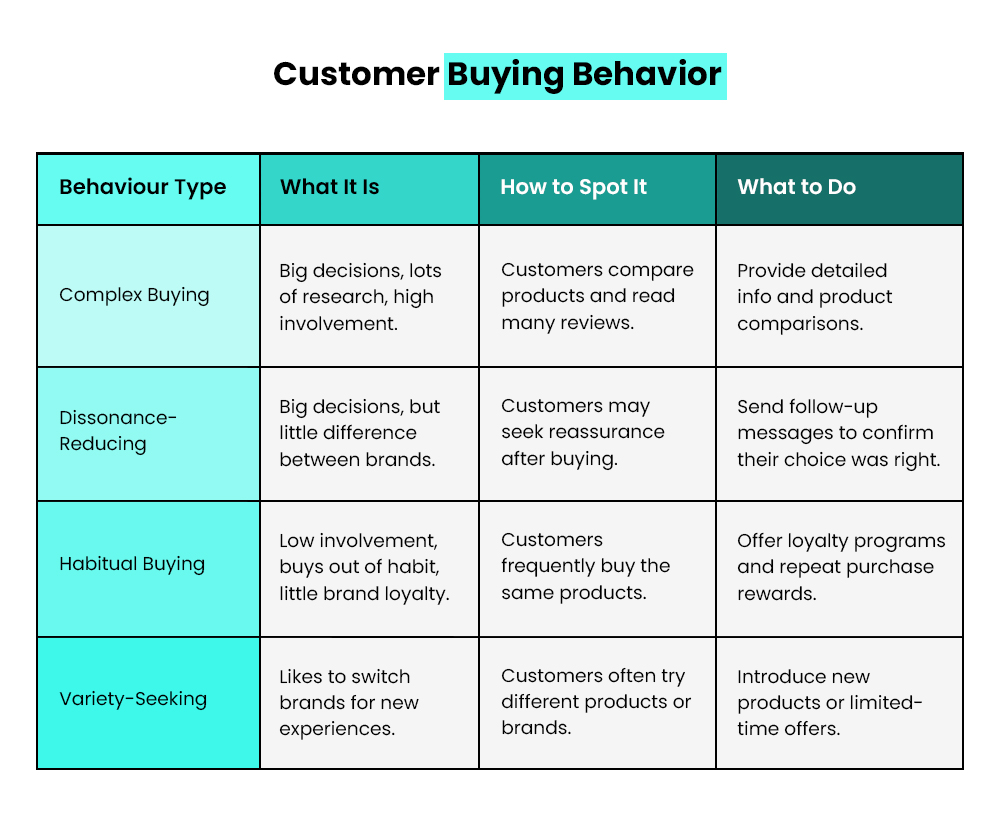
Consumer behavior significantly impacts eCommerce businesses by dictating how customers interact with online stores. Here are some of them:
1. Website Design and User Experience (UX)
Website design and UX significantly impact online purchasing behavior. A seamless and intuitive experience is crucial for conversions. Consider these points:
- Ease of navigation- Clear menus and search functionality enable online shoppers to find products quickly.
- User retention and experience-A poor user experience can lead to significant losses; 90% of users have stopped using an app due to poor performance.
- Fast loading speed- Slow-loading pages lead to frustration and cart abandonment.
- Clear product information- Detailed descriptions, images, and videos help consumers make informed decisions.
- Secure checkout process- A safe and trustworthy checkout process builds confidence.
Understanding trends in consumer behavior regarding UX is essential for eCommerce businesses to thrive.
2. Marketing and Advertising Strategies
Effective marketing and advertising strategies play a crucial role in influencing shopping habits and driving eCommerce success. Businesses must align their marketing campaigns with consumer preferences to maximize engagement and conversions.
- Personalization: Targeted ads and product recommendations enhance customer experience by catering to individual preferences.
- Social media marketing: Platforms like Instagram and TikTok shape consumer decisions through influencer partnerships and viral content.
- Email and retargeting: Data-driven email campaigns and retargeting ads keep brands top-of-mind.
Adapting strategies to evolving shopping experiences ensures long-term growth and customer retention.
3. Pricing and Promotions
Pricing and promotions play a key role in shaping online purchase behavior, as consumers actively compare prices before making decisions. Competitive pricing strategies and enticing promotions can significantly influence sales and customer retention.
- Dynamic pricing: AI-driven pricing models adjust prices based on demand, competition, and customer behavior.
- Discounts and deals: Limited-time offers to create urgency, encouraging quick purchases.
- Loyalty programs: Reward-based incentives develop brand loyalty and repeat business.
- Free shipping & bundles: Added value influences purchase decisions and increases order size.
Understanding how consumers compare prices helps businesses craft effective pricing strategies to maximize conversions and revenue.
4. Customer Service and Support
Customer service and support help in shaping the shopping consumer experience and directly impact customer satisfaction. A seamless support system builds trust. Encourages repeat purchases, and enhances brand loyalty.
- 24/7 Support and Chatbots: Instant responses through AI-powered chatbots improve user experience and resolve queries efficiently.
- Multi-Channel Assistance: Providing support via email, social media, and live chat ensures accessibility.
- Easy Returns & Refunds: A hassle-free return policy increases trust and confidence in purchases.
- Personalized Assistance: Tailored responses make customers feel valued, boosting engagement.
Strong customer support enhances customer satisfaction, developing long-term relationships and brand credibility.
5 Strategies for Leveraging Consumer Behavior Insights
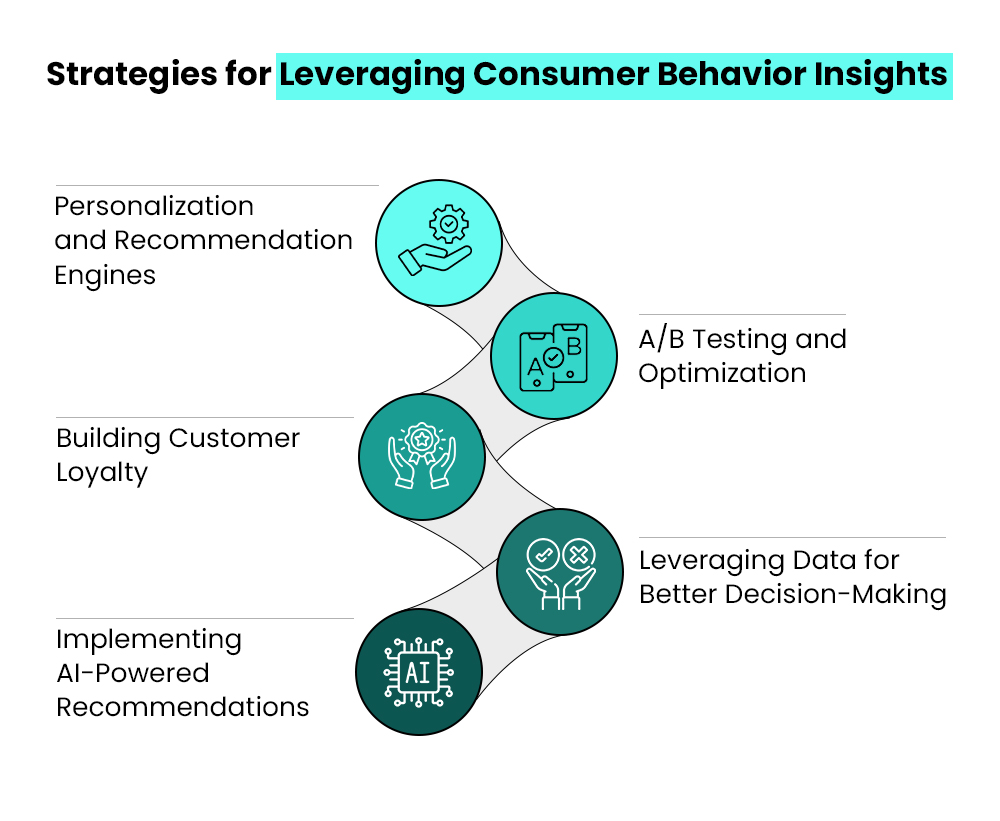
Online businesses can implement the following strategies to leverage consumer behavior insights:
1. Personalization and Recommendation Engines in Consumer Behavior
Leveraging consumer behavior insights allows businesses to craft powerful personalization strategies that enhance the shopping experience and drive sales. Recommendation engines analyze past purchases and browsing history to suggest relevant products, making shopping more efficient and enjoyable.
Take Zalando, for example—this fashion retailer uses AI-driven personalization similar to Netflix’s recommendation model. By studying a shopper’s past purchases, browsing behavior, and even body measurements, Zalando suggests outfits and styles tailored to individual preferences. This reduces decision fatigue and increases the likelihood of purchase.
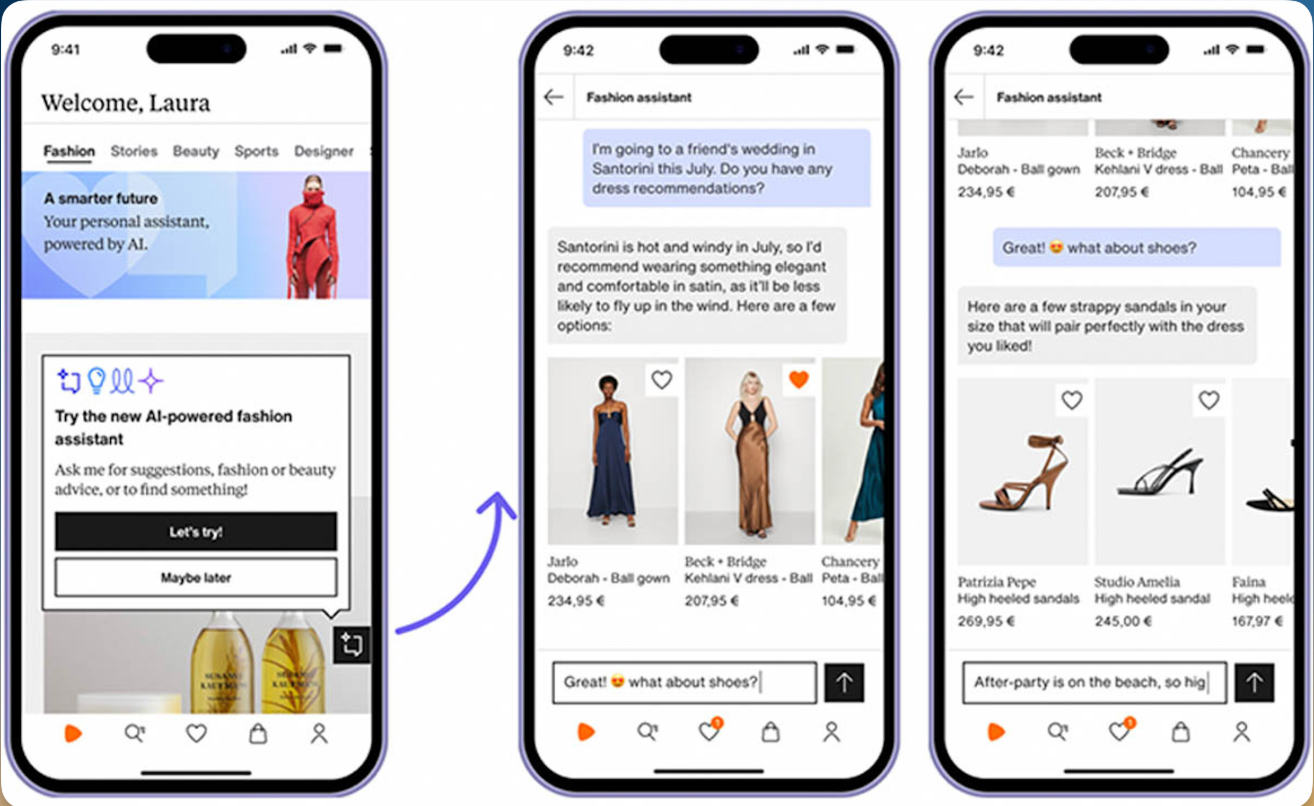
The impact of personalization is undeniable. A study by Epsilon found that 80% of consumers are more likely to buy from brands that offer personalized experiences.
Businesses that tap into consumer insights can create targeted marketing campaigns, personalized email promotions, and tailor-made website experiences, leading to greater engagement and customer loyalty. Additionally, understanding consumer behavior helps businesses optimize product placement and inventory management.
As shoppers expect more tailored experiences, brands that leverage data-driven personalization will continue to thrive in the evolving eCommerce landscape.
– Also Read- How to Rank Higher in AI Search Engines like Google and Bing?
2. A/B Testing and Optimization
A/B testing is a vital strategy in eCommerce to leverage trends of consumer behavior to optimize user experiences and boost conversion rates. By presenting different versions of a webpage or element to distinct user segments, businesses can identify which variant resonates more effectively with their audience.
This method provides substantial data on customer preferences, enabling informed decisions that enhance engagement and sales.
For instance, Grene, a prominent eCommerce brand, redesigned its mini cart through A/B testing and observed a 2X increase in overall purchase quantity.
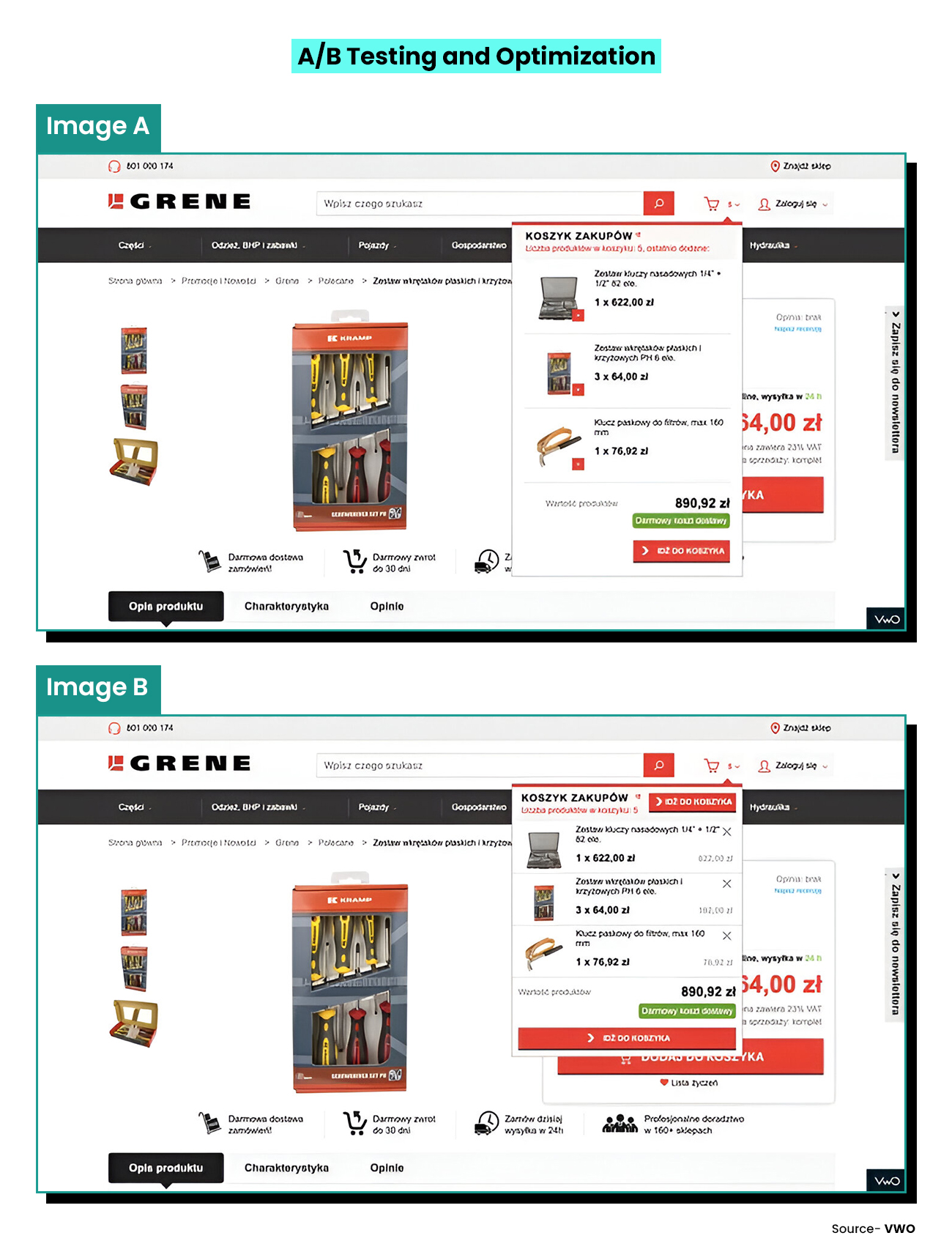
This example highlights the significant impact that data-driven optimization can have on consumer purchasing behavior. Implementing systematic A/B testing allows eCommerce platforms to continually refine their strategies, ensuring alignment with evolving customer expectations in the market.
3. Building Customer Loyalty
Building customer loyalty in eCommerce starts with a deep understanding of consumer behavior. By analyzing purchase patterns, preferences, and engagement metrics, businesses can craft personalized experiences that resonate with their audience.
Offering tailored recommendations, exclusive rewards, and seamless support fosters trust and long-term relationships.
A great example is Starbucks Rewards, which uses gamification and data-driven personalization to keep customers engaged. Points-based incentives, personalized discounts, and birthday rewards encourage repeat visits, strengthening emotional loyalty.
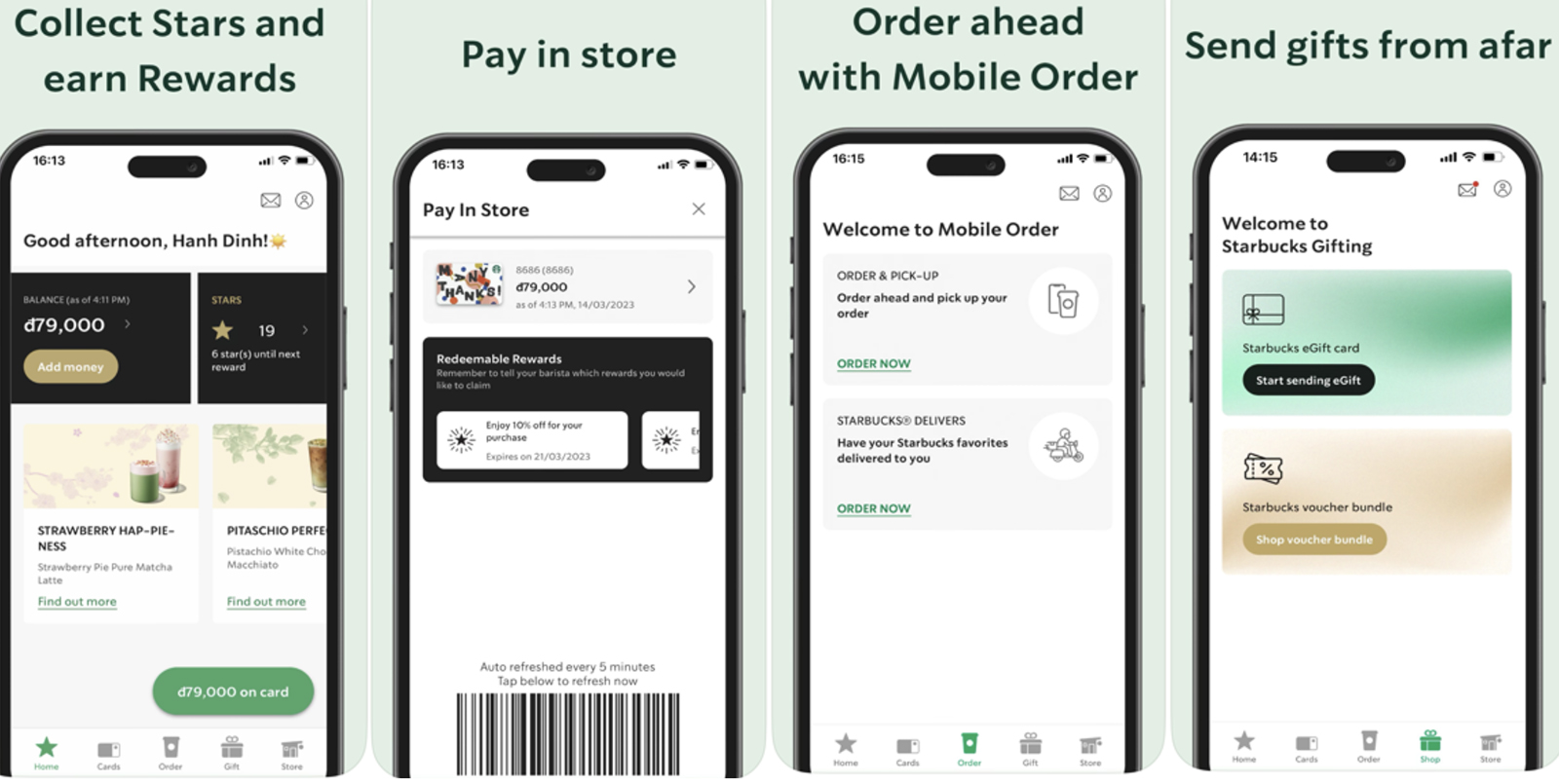
Similarly, eCommerce search behavior analysis helps brands pinpoint key touchpoints where they can enhance satisfaction and drive repeat purchases. Leveraging predictive analytics, businesses can anticipate customer needs and proactively address concerns, making shoppers feel valued.
When customers have a positive, tailored experience, they are more likely to become loyal advocates, spreading the word and driving organic growth. By continuously adapting to evolving expectations, businesses can turn occasional shoppers into devoted brand ambassadors.
4. Leveraging Data for Better Decision-Making
Using data-driven insights is essential for making smart business decisions in eCommerce. By analyzing consumer behavior patterns, businesses can optimize pricing, marketing strategies, and product offerings to match customer preferences.
Studies show that 91% of consumers are more likely to shop with brands that offer personalized recommendations, proving the power of data in influencing purchasing decisions. Advanced analytics tools help businesses identify trends, predict demand, and enhance the customer experience.
For instance, Walmart continuously analyzes competitor pricing, consumer demand, and shopping trends to dynamically adjust prices. This strategy keeps Walmart competitive, attracts more shoppers, and maximizes profitability.
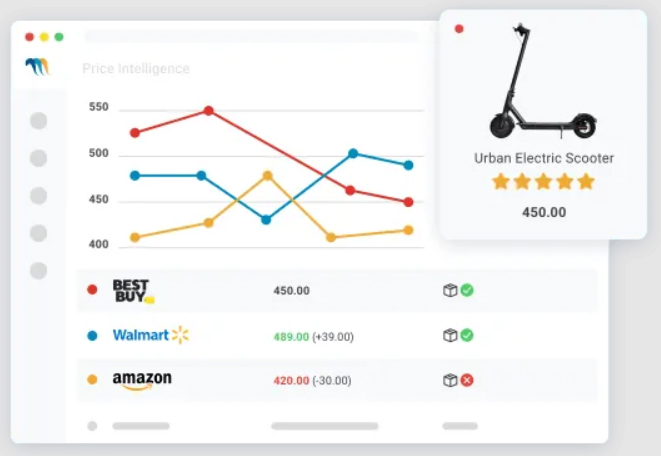
Real-time data also enables brands to adapt quickly to market shifts, ensuring they stay ahead of changing consumer expectations. When decisions are backed by insights, businesses can build trust, enhance customer loyalty, and drive long-term growth in the eCommerce space.
5. Implementing AI-Powered Recommendations
AI-powered recommendation engines have revolutionized eCommerce by personalizing the shopping experience and shaping purchasing decisions. By analyzing past purchases, browsing habits, and demographic details, these smart algorithms suggest products that align with individual preferences, making shopping more seamless and engaging.
This personalization not only enhances customer satisfaction but also significantly boosts sales. Amazon attributes up to 35% of its revenue to its AI-driven recommendation system.
For example, the platform analyzes customer behavior, purchase history, and search patterns to offer tailored product suggestions. Features like “Recommended for you” and “Customers who bought this also bought” have significantly boosted cross-selling and upselling opportunities, increasing order values.

Beyond personalization, AI-powered recommendations help brands deepen customer engagement and loyalty by providing relevant, real-time suggestions. As AI technology advances, its role in eCommerce will continue to grow, making shopping more intuitive, efficient, and profitable for businesses.
Latest Trends in eCommerce Consumer Behavior
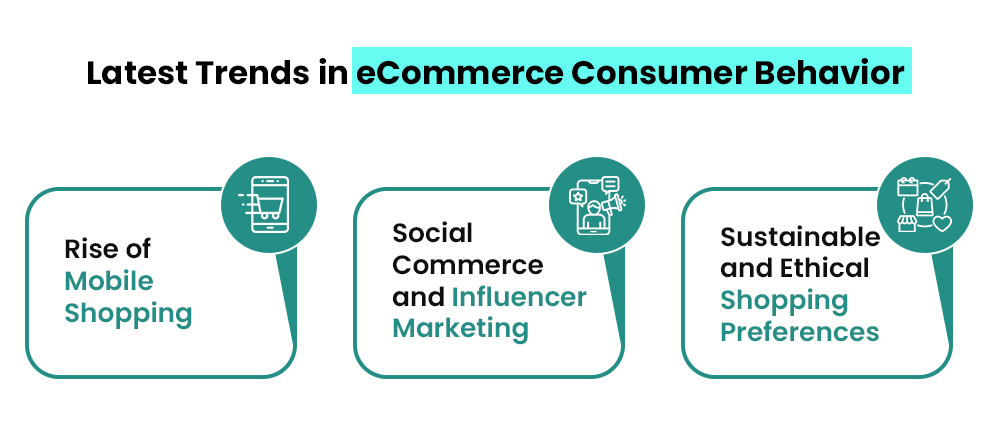
If we know one thing about the eCommerce market, it’s always evolving. Let’s see the latest trends in eCommerce consumer behavior here:
1. Rise of Mobile Shopping
Consumers being able to shop from anywhere and anytime is the biggest impact eCommerce has had on shopping habits. The rise of mobile shopping has taken eCommerce to the next level because shoppers can use the device at any point during the sales cycle.
Mobile sales are projected to reach $728.28 billion and make up 44.2% of retail commerce sales in the US by 2025. Throughout the sales cycle, consumers use mobile in a variety of different ways:
- To explore new products
- To compare prices and locate products
- To create shopping lists
- To make buying decisions
- To rate/review purchases
Between the physical store and online experience, the rise of mobile shopping has blurred the line. Both channels can be used in conjunction to optimize the shopping experience rather than having two distinct channels.
The businesses that have been able to make the transition have created apps, optimized their eCommerce stores, and started selling products through their social media channels.
2. Social Commerce and Influencer Marketing
When many social media users use different platforms to research products, eCommerce businesses should take advantage of this trend. Businesses can conveniently execute campaigns to reach their prospective customers thanks to built-in eCommerce platforms, such as Instagram shopping, TikTok shops, Facebook shops, and Pinterest’s shopping ads.
To make the most of mobile shopping, social media is an effective retail sales channel. According to social commerce statistics by Hostinger, social media commerce sales are expected to reach $8.5 trillion by 2030.
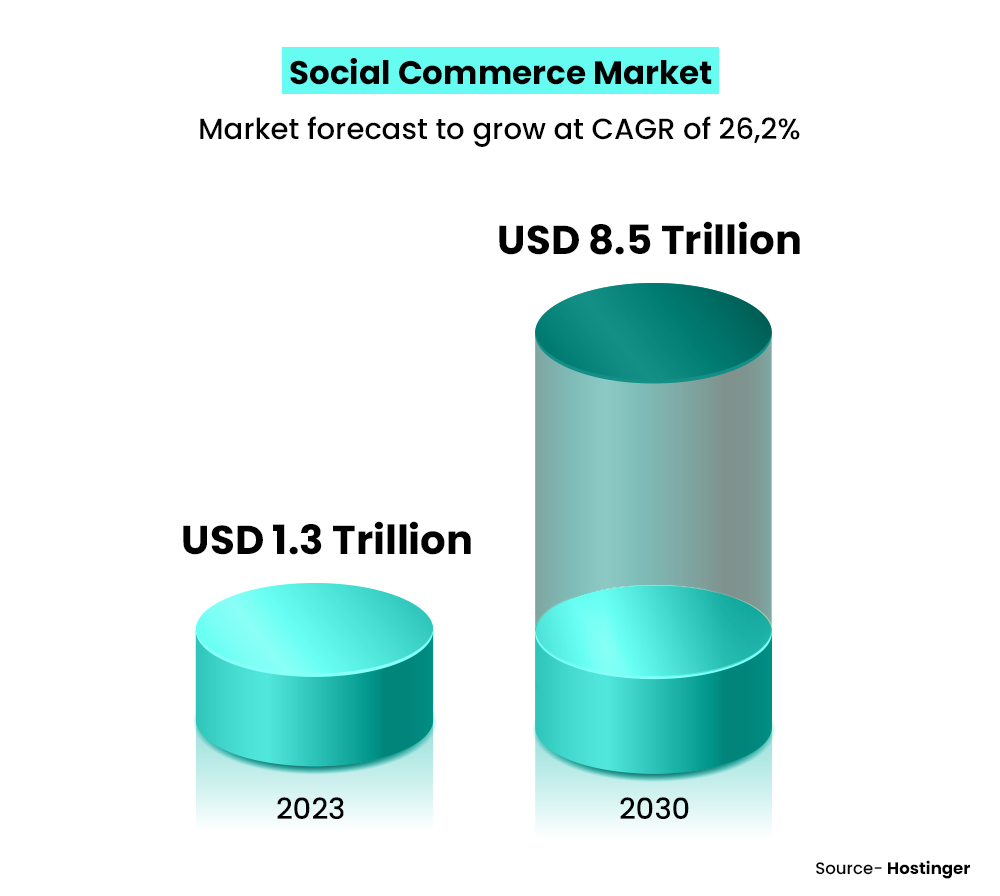
For new eCommerce brands, selling from social media channels can be a great solution for a cost-effective marketing strategy. Business owners can integrate influencer marketing and live shopping to boost sales.
With lower costs, influencer marketing helps drive organic traffic and attract new customers. When compared to branded posts, 60% of marketers found that influencer-generated content drives more engagement and performs better.
3. Sustainable Shopping Preferences
Sustainability is no longer just a buzzword for today’s online shoppers. For sustainability-produced goods, more than 70% of shoppers said they would be willing to pay more according to a recent study by PwC.
Younger shoppers are favoring the brands that prioritize ethical and eco-friendly practices over those that don’t, especially in the fashion and apparel industry. The Drapers survey found that 57% of Gen Z and Millennials say sustainability is important when it comes to shopping for clothes, accessories, or shoes.
This shift in purchasing decisions reminisces a growing trend where consumers increasingly view the environmental impact of their buys, influencing their loyalty and overall brand perception.
– Also Read- Top 10 Ecommerce Trends You Should Know in 2025
Conclusion
Understanding consumer behavior in eCommerce is essential for businesses looking to thrive in a competitive market. By leveraging data-driven insights, brands can personalize customer experiences, optimize marketing strategies, and enhance product offerings.
AI-powered recommendations, behavioral analytics, and targeted engagement strategies help businesses build lasting relationships and drive customer loyalty. As consumer preferences evolve, staying ahead requires continuous adaptation and a customer-centric approach.
Businesses that effectively analyze and respond to changing customer behavior can boost sales, increase retention, and gain a competitive edge. In the digital age, success depends on understanding what drives purchasing decisions and using that knowledge to create seamless shopping experiences that keep customers coming back.
We at Mastroke design effective marketing strategies for eCommerce brands that help them grow their businesses at a rapid pace. Contact us today for more information!
This is a highly informative piece that unpacks how evolving consumer behavior is reshaping eCommerce—from mobile shopping and social commerce to AI-driven personalization. The detailed analysis of trends and data-driven strategies offers a clear roadmap for businesses aiming to boost engagement and foster long-term loyalty. For more advanced digital marketing insights, be sure to visit seosouq.com.